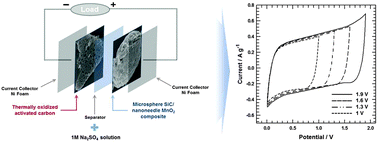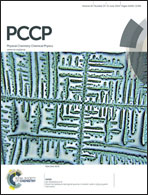Development of high power and energy density microsphere silicon carbide–MnO2 nanoneedles and thermally oxidized activated carbon asymmetric electrochemical supercapacitors†
Abstract
In order to achieve high energy and power densities, a high-voltage asymmetric electrochemical supercapacitor has been developed, with activated carbon (AC) as the negative electrode and a silicon carbide–MnO2 nanoneedle (SiC–N-MnO2) composite as the positive electrode. A neutral aqueous Na2SO4 solution was used as the electrolyte. SiC–N-MnO2 was prepared by packing growing MnO2 nanoneedle crystal species in only one direction on the silicon carbide surface. AC was oxidized by thermal treatment in order to introduce oxygen-containing functional groups. Owing to the high capacitance and excellent rate performance of SiC–N-MnO2 and AC, as well as the synergistic effects of the two electrodes, a constructed asymmetric supercapacitor exhibited superior electrochemical performance. The optimized asymmetric supercapacitor could be cycled reversibly in the voltage range from 0 to 1.9 V, and it exhibited a specific capacitance of 59.9 F g−1 at a scan rate of 2 mV s−1 and excellent energy density and power density (30.06 W h kg−1 and 113.92 W kg−1, respectively) with a specific capacitance loss of less than 3.1% after 1000 charge–discharge cycles, indicating excellent electrochemical stability. These encouraging results show great potential in terms of developing energy storage devices with high energy and power densities for practical applications.


 Please wait while we load your content...
Please wait while we load your content...